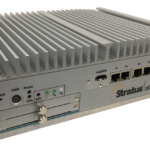Stratus Technologies is a US-based company with a global presence in a range of industries, including the industrial market. It has been in business for 39 years.
Over the course of its history, the company has been building ‘ultra-reliable’ computing platforms with data centre and data closet-type products. But over the last few years, they’ve transitioned into an edge computing provider; “over 60% of our product revenues now comes from edge deployments,” confirms Jason Andersen, vice president, strategy and business line management at Stratus.
During this transition, the focus and attention has not only been on the product development strategy but also the company’s go-to-market strategy – it’s now all about being a premier edge computing platform provider.
“It’s very much an evolution for us, it’s a deepening of our relationship into our market segments,” continues Andersen. “Compared to three years ago we would view ourselves more as a horizontal technology provider. Now we’re more a solution provider into industrial automation, energy, financial services and transportation.”
The CTO’s guide to edge computing
Information Age’s comprehensive guide to edge computing for CTOs and business leaders. Read here
Defining edge computing
Every one is relatively new to the edge computing space.
What does it mean? Broadly, it can be defined as the ability to process and filter data near the machine and near the point of production.
Within that, there are what Andersen calls “edge computing subsets”:
“You’ve got gateways, which essentially just push data round or translate data into a format that’s acceptable by a modern computer; you’ve got your IPC market, which is industrial PCs doing a whole variety of different things, running SCADA applications and doing machine learning.”
 The ztC Edge
The ztC Edge
This is where our new product sits, in what we’d call the edge server space. It is a virtualised device which has more robust IT feature set in it, over and above what an IPC can do.
Even though some of them have the same exact form factor, the software inside is very different. It allows it to do different things but those are three subsets of the broader edge computing market that Stratus looks at, studies and partners around.
— Andersen
Facilitating industry 4.0
Organisations are on different steps of the industry 4.0 journey.
With Stratus, it does a healthy amount of what Andersen calls a “mid-size factory refresh” for its clients. This is “our staple industrial business,” he says. In this scenario, a customer will come and ask for an updated SCADA application, for example. Stratus will deploy an edge computer, now, to do that.
There’s still a lot of industrial 3.0 software and hardware out there, so many organisations are in need of a refresh.
But, steadily, organisations are starting to design the infrastructure with industry 4.0 in mind. “I’m going to buy extra capacity and design everything around the software I’m going to need tomorrow,” emphasises Andersen.
Reinforcing the point, he then refers to one of Stratus’ big partners, AVEVA:
“We’ve talked a lot about this particular situation, because how they’re treating their software architecture has become more container-driven and cloud-aware. We’re adapting our platform to work with them as well. It’s an example of how we’re trying to help the customer evolve versus a more revolutionary approach.”
Augmented reality: the new business tool driving industry 4.0
Security by design
Industry 4.0 requires a new way of thinking when it comes to design.
Security has to be included in the design process and deploying an edge server can help with this. The virtualisation on it means that organisations running ten-year-old hardware can carry software forward and update accordingly.
Typically, an enterprise customer will replace servers after three or four years. But, that’s because the status quo is focused on quick turnaround and end-of-life policies.
It all comes down to life cycle. “The industrial customer base that doesn’t want to replace equipment often, they have a different buying model. How do you match the world of the people who focus on enterprise technology towards that,” asks Andersen?
“If you’re a typical IT or enterprise software vendor, you’re going to push to replace every three to five years.
But, we’ve been going to market for years and, for example, we’ve had partners in Japan telling us we need your guarantee that you’ll support it for 12 years.”
“We’re starting to build an integrated experience around security and protection” — Andersen
Edge facilitates the autonomous
Stratus is now an edge-focused company. It is shedding some of the availability and fault tolerance moniker, but still delivering that in its products.
“All we’re doing is taking the technology we have and putting it into a more broadly applicable place and building functionality that is more broadly applicable,” says Andersen.
“That’s why I’m really excited about our latest release — it’s the first big step away from our heritage products.
“The product we introduced last year was really to test the market and now, it’s a different beast entirely.”







